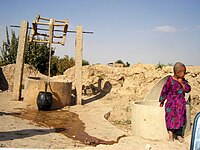
Photo from wikipedia
Wetlands in the Prairie Pothole Region (PPR) of North America support macroinvertebrate communities that are integral to local food webs and important to breeding waterfowl. Macroinvertebrates in PPR wetlands are… Click to show full abstract
Wetlands in the Prairie Pothole Region (PPR) of North America support macroinvertebrate communities that are integral to local food webs and important to breeding waterfowl. Macroinvertebrates in PPR wetlands are primarily generalists and well adapted to within and among year changes in water permanence and salinity. The Williston Basin, a major source of U.S. energy production, underlies the southwest portion of the PPR. Development of oil and gas results in the coproduction of large volumes of highly saline, sodium chloride dominated water (brine) and the introduction of brine can alter wetland salinity. To assess potential effects of brine contamination on macroinvertebrate communities, 155 PPR wetlands spanning a range of hydroperiods and salinities were sampled between 2014 and 2016. Brine contamination was documented in 34 wetlands with contaminated wetlands having significantly higher chloride concentrations, specific conductance and percent dominant taxa, and significantly lower taxonomic richness, Shannon diversity, and Pielou evenness scores compared to uncontaminated wetlands. Non-metric multidimensional scaling found significant correlations between several water quality parameters and macroinvertebrate communities. Chloride concentration and specific conductance, which can be elevated in naturally saline wetlands, but are also associated with brine contamination, had the strongest correlations. Five wetland groups were identified from cluster analysis with many of the highly contaminated wetlands located in a single cluster. Low or moderately contaminated wetlands were distributed among the remaining clusters and had macroinvertebrate communities similar to uncontaminated wetlands. While aggregate changes in macroinvertebrate community structure were observed with brine contamination, systematic changes were not evident, likely due to the strong and potentially confounding influence of hydroperiod and natural salinity. Therefore, despite the observed negative response of macroinvertebrate communities to brine contamination, macroinvertebrate community structure alone is likely not the most sensitive indicator of brine contamination in PPR wetlands.
Journal Title: Environmental pollution
Year Published: 2018
Link to full text (if available)
Share on Social Media: Sign Up to like & get
recommendations!